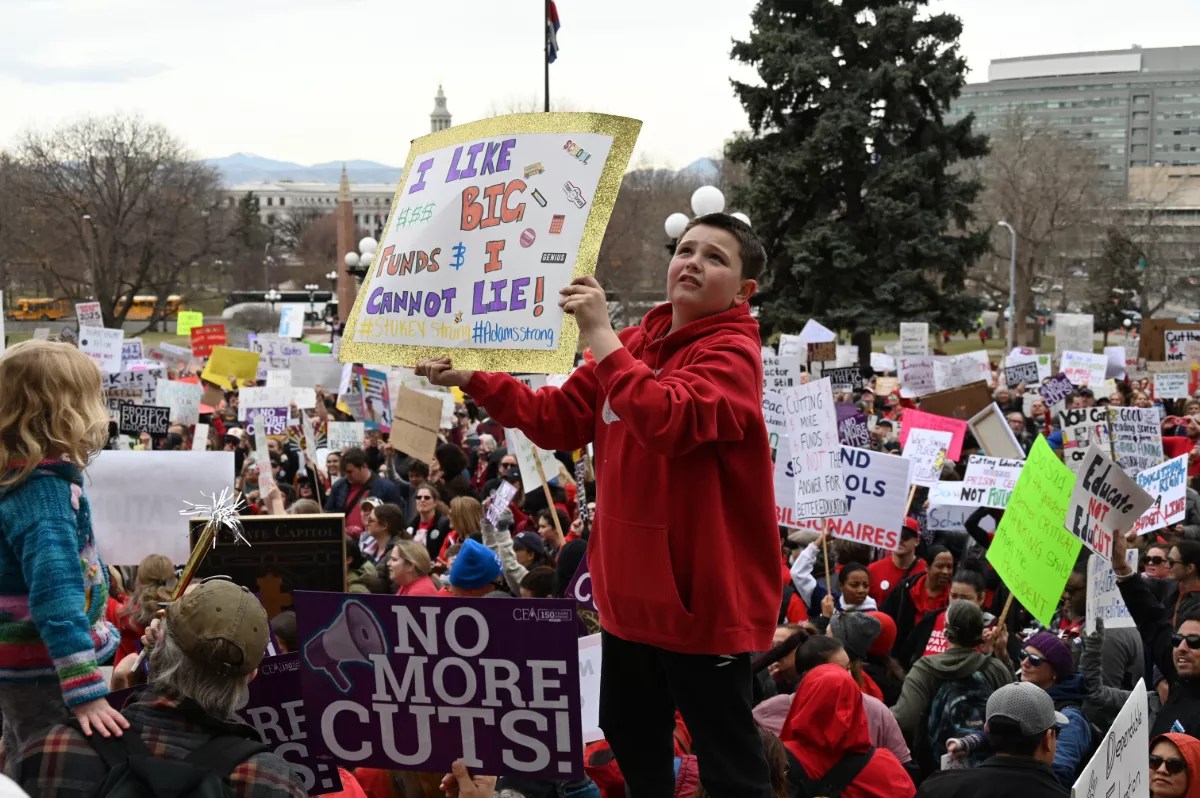
Bennito L. Kelty

Audio By Carbonatix
Thousands of Colorado teachers, parents and kids gathered at the Colorado State Capitol on Thursday, March 20, to demand more funding for public schools and protest possible cuts as the state deals with a $1 billion budget shortfall.
“Kids need a chance to do their best,” said Siobhan Holland, a teacher for twenty years in the Adams 12 Five Star School District who came out to protest against cuts. “They need the funds and resources that will help them be successful.”
Donning red shirts and sweaters printed with words “Red for Ed,” an estimated 4,000 protesters amassed at the Capitol’s west lawn to support public education funding on Thursday, according to the Colorado State Patrol, with signs reading “fully fund public education” and chants of “no more cuts.”
The Colorado Education Association, the largest teachers union in the state, organized the “No More Cuts” protest to “demand no more cuts to education and call for the fully funded public schools Colorado students deserve,” according to CEA’s call for action earlier this week.
This year, make your gift count –
Invest in local news that matters.
Our work is funded by readers like you who make voluntary gifts because they value our work and want to see it continue. Make a contribution today to help us reach our $50,000 goal!
The CEA-led protest resulted in teachers across Colorado school districts taking the day off, which in turn led to students across the state getting the day off. Dozens of schools in Denver, Boulder and Aurora cancelled classes due to expected teacher absences. Denver Public Schools, the largest district in Colorado, reported that about two-thirds of its schools had cancelled classes.
The state is facing a $1.2 billion budget shortfall heading into the fiscal year that starts in July, and the CEA fears that state lawmakers will cut education spending to cover the deficit. In an attempt to balance the upcoming $40 billion state budget, Governor Jared Polis proposed cuts to Building Excellent Schools Today (BEST), which funds construction at schools in part through lottery and marijuana excise taxes.
Polis criticized the protest, saying “the best place for kids is in the classroom,” in a statement on Tuesday, March 18, a couple days ahead of the protest.
“Canceling school at the last minute in several districts on 3/20/25 will put strains and hardships on parents and will leave kids without instruction and many without a safe place to go,” Polis said. “Let’s remember that nearly 70 percent of third graders can’t read or do math on grade level, and this leaves parents scrambling to find care.”
The CEA blames the budget shortfall on “restrictions created by TABOR,” a Colorado tax law that limits how much tax revenue the state can collect. Protesters on Thursday carried signs reading “end TABOR” and “TABOR steals from students.”
According to the CEA, Colorado schools require upwards of $4.1 billion in additional funding to “ensure smaller class sizes, updated learning materials and critical student support services,” according to the group’s March 20 press release.
Protester Thad McCauley, an art teacher for 24 years in Aurora Public Schools, predicts education funding cuts will lead to larger class sizes “because teachers will be cut,” and that “teachers will be living at a lower income level because there will be no cost-of-living raises available.”
Protester Samantha Molosky, a teacher at Rangeview High School, told Westword that she is worried cuts will impact student services like counseling, special education and monitoring truancy and attendance problems.
“The support that we rely on to help make student experiences the best they can be will vanish,” Molosky says. “We’ll be left to meet the needs of all our students when we don’t have the capacity.”
Fellow Rangeview teacher Mike Szalay agreed with Molosky’s fear of losing services, which often make “the difference between a kid being successful and falling through the cracks completely,” Szalay said.
“Having fully funded schools means having the adequate staff that we need to give attention to all of the students,” Szalay added. “Underfunded schools means larger class sizes, cutting programs, extracurriculars, just really making the education system less effective.”
According to Holland, that the Adams 12 District is already dealing with “really packed” classrooms and “there are a lot of teachers sharing spaces.”
Molosky said that she already feels the pinch and pressure of a tight classroom budget and that the school only barely has enough to support students as it is.
“Right now, it feels like we’re working with just enough to get by, and we’ve figured out to make do with what we have,” Molosky said. “But it feels like we’re hanging on by a shoestring.”